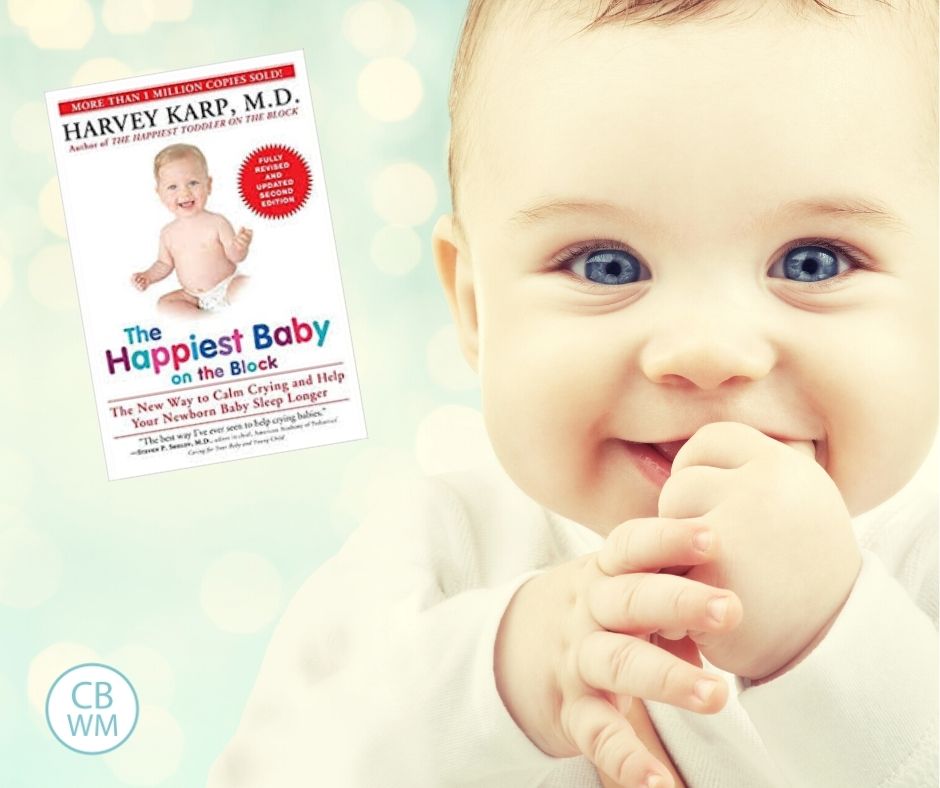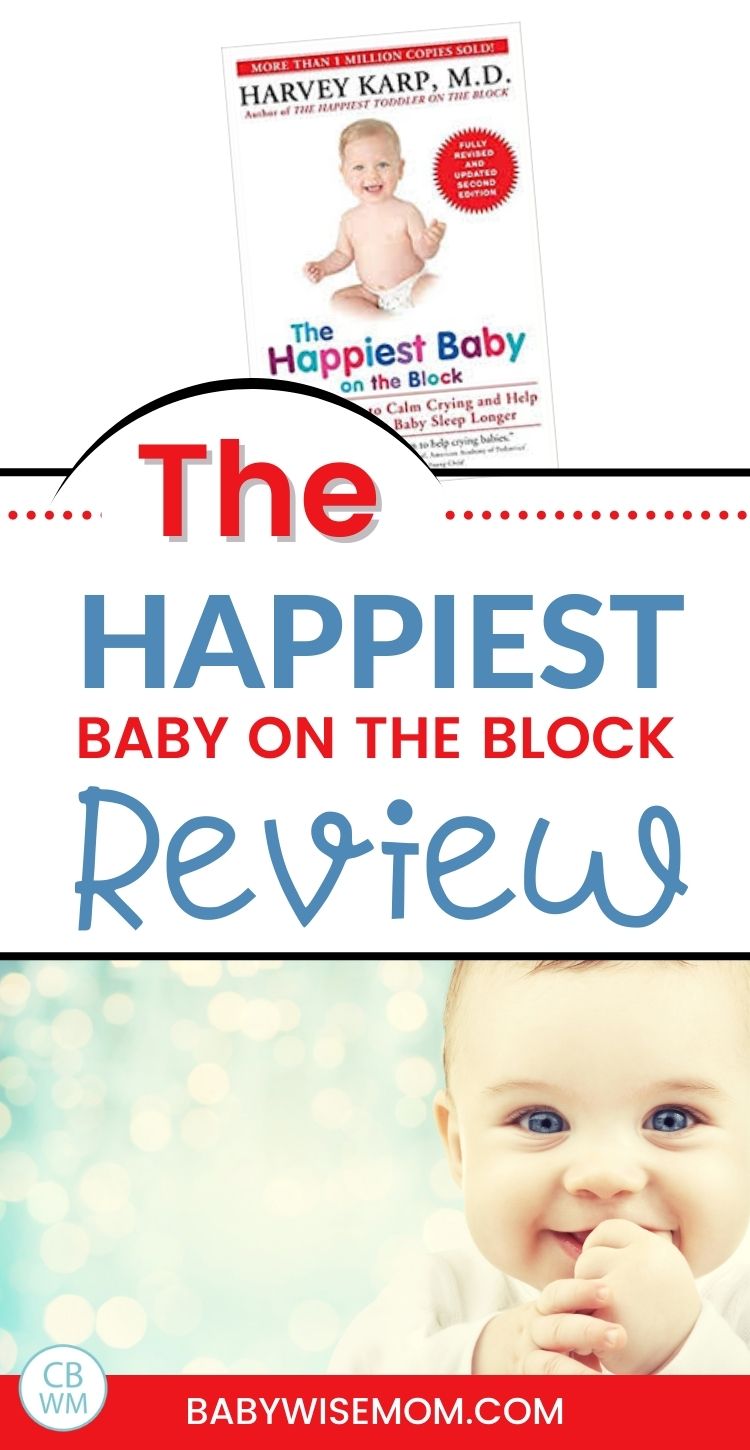Book review of The Happiest Baby on the Block by Harvey Karp, M.D. Learn what is in this book and if it is worth reading and helpful for babies.

I see The Happiest Baby on the Block book recommended occasionally by moms and was interested in reading it.
This review session will be a bit different than my others. Other reviews of books have been done after I have finished the entire book. This time, I am going to review as I read it. The downside to this is that I can’t give my overall opinion yet. I think with my pregnant brain, however, this will prove to be most effective at this time. This way I will be able to remember the most for the post. In this post I will be reviewing chapters 1-7.
Here are some points of interest.
Post Contents
- The 4th Trimester
- The 5 S’s
- Crying Isn’t Manipulative
- Parents Cannot Distinguish Meaning in a Newborn’s Cries (I Disagree)
- Babies Do Not Ever Need to Cry to “Blow Off Steam” (I Disagree)
- Need to Imitate Womb
- Top 10 Ways to Imitate the Uterus
- Newborn Expectations
- 5 S’s
- Use Vigor
- It Takes Time
- Conclusion
- Related Posts
- Reader Comments
The 4th Trimester
In chapter 1, Karp mentions the “4th trimester.” The 4th trimester refers to the first three months of a baby’s life. I have heard the first three months called this before, and I agree that it is a fair lable for those first three months. He discusses the fourth trimester later on in the book, so I will save more thoughts for then.
The 5 S’s
Karp has 5 S’s to use to calm a fussy baby:
- Swaddling
- Side/Stomach laying
- Shushing
- Swinging
- Sucking
He says that a mildly fussy baby can be soothed by using one of these methods, but a really fussy, or colicky, baby needs all five together in his recipe to create the “Cuddle Cure.”
Crying Isn’t Manipulative
In Chapter 2, Karp discusses crying and points out that a baby’s cries are not manipulative (page 21). I have mentioned this a few times in various posts. The Baby Whisperer, Tracy Hogg, discusses this. I like to point this out because I often hear parents refer to their babies this way (See Combating Babywise Myths #6: BW parents call their kids words like “manipulative”).
I agree with Hogg and Karp that your baby does not cry in order to manipulate you.
Parents Cannot Distinguish Meaning in a Newborn’s Cries (I Disagree)
In Chapter 2, Karp states that parents cannot distinguish meaning until possibly 3 months of age (page 22). I very much disagree with this.
I know I got to know the cries of my children long before three months. Tracy Hogg also claims to be able to distinguish between cries of a newborn.
Karp sites a study done by the University of Connecticut in 1990 that he claims proves parents cannot decipher meaning in a baby’s cry.
The study basically had mothers listen to recorded cries of babies and tell what the cry meant. Researchers in Finland did the same with baby nurses. Moms were right less than half the time while nurses were right about half of the time.
I find problems with these studies. One problem I have is who were these researchers to decide what the baby’s cries meant in the first place. The people responding to this study were wrong or right based on the researchers’ determination of what the cry meant.
If Karp is correct in stating that we cannot distinguish meaning in cries, then these studies in no way could possibly prove nor disprove that. If there is no possible way to distinguish among cries, then the researchers couldn’t have done so in order to judge whether the moms and/or nurses could do so.
>>>Read: Tips for Deciphering Your Baby’s Crying
Babies Do Not Ever Need to Cry to “Blow Off Steam” (I Disagree)
In Chapter 3, Karp states that he strongly disagrees with experts who have “guessed” that some babies need to cry to unwind from the day (page 30).
I strongly disagree with him.
I believe that some babies need to cry sometimes. Perhaps even all babies need to cry every day. I remember reading in a book printed by the American Academy of Pediatrics that all newborns need to cry for at least one hour a day.
I don’t have the book to reference it, so take that information for what it is worth. Suffice it to say I disagree with Karp on this.
Need to Imitate Womb
On page 81, Karp states that “stone age” people realized the need to imitate the womb.
When I read this, it reminded me of the statement found in Babywise that suggests cultures that carry the baby around with them all day and co-sleep, etc. do so out of need, not out of a belief it is the best way (sorry I don’t have the reference, a friend is borrowing my book right now).
Top 10 Ways to Imitate the Uterus
These can be found on page 93. While your goal might not be “imitating the uterus,” this list might be helpful if you have a fussy baby:
holding, dancing, rocking, wrapping, white noise/singing, car rides, walks outside, feeding, pacifiers, and swings.
I personally would add structure, adequate sleep, and avoiding overstimulation.
Take note that many of the top 10 items listed by Karp can create overstimulation or make overstimulation worse.
>>>Read: How To Calm Your Overstimulated Baby
Newborn Expectations
On page 83, Karp says our babies expect us to handle them like our “stone age” ancestors did. I found this funny. When I read this, I was reminded of his earlier statement that “babies are just babies” (page 47).
For baby that is “just” a baby, that is quite the expectation.
5 S’s
Chapter 7 starts to get into the 5 S’s, which is what readers have told me is the best part of the book.
This is not to be confused with the 4 S’s from Tracy Hogg, though there is some similarity between the two.
- Swaddling: “Many irritable babies resist wrapping. However, it’s a mistake to think this resistance means your baby needs his hands free” (page 95). I really disagree with this. It was obvious from the first day of Brayden’s life that he hated swaddling. We didn’t swaddle him. Kaitlyn, however, loved it–though as she got older she got very particular about how she wanted to be swaddled, and that changed over time. (see this Swaddling posts for more).
- Side/Stomach: Karp says to place your baby on side or stomach in order to shut off the Moro reflex (the feeling of falling when baby is on back). Both of my children, however, hated stomach positions and much preferred backs. Even before we started Babywise with Brayden and he would have his crying fits, he wanted to be on his back on a bed with us holding his arms. That is what calmed him. So while I know the side/stomach position works for many babies, I don’t think that means all babies prefer it.
- Shhh…: Shhh or white noise like a vacuum. Before we started Babywise, we did try the vacuum thing with Brayden. One time it worked. Other times, not. We never needed to try it with Kaitlyn, and never needed to try it with Brayden after starting Babywise.
- Swing: The swing was something both of my children liked.
- Sucking: Karp says this is the “icing on the cake” (page 98). He says this helps baby to maintain the calm state.
Use Vigor
Karp says you must be forceful when applying these steps to your baby. He points out the vigor of nurses in the hospital (page 99).
I remember when Kaitlyn was in the NICU. I was shocked at how roughly the NICU nurses handled the babies–and she was my second!
Karp says to match the level of intensity of your baby’s crying. The louder the cry, the more vigor you apply. As the crying subsides, you ease up on your vigor.
It Takes Time
Karp says getting the 5 S’s to work takes time. Not only do you need to practice, but there are three reasons he states babies take time before the 5 S’s work.
One is that babies brains have a hard time shifting gears. Another is that their brains are slow to respond. The third is that babies brains get into a cycle of crying (page 102).
If you are interested in the 5 S’s, there is a chapter devoted to each S.
Also, I agree with many who have commented that it might be better to watch the DVD of Karp doing these 5 S’s rather than reading the book. That way you skip all of the “theory” behind it and just see the 5 S’s in practice. Also, it is probably easier to figure out what to do by watching him do it than it is to read how to do it.
Conclusion
So far, I am not sure what I think about this book. Karp seems to have very different theories from Ezzo and Hogg, two authors I tend to agree with.
Therefore, I am inclined to say I will not agree with much in this book, but I am trying to keep an open mind as I read on. I am hoping to find the helpful information that some parents swear saved their babies.
Related Posts
- How to Help Your Baby Sleep Better With Swaddling
- Helpful Tips to Survive the Colicky Newborn
- Four Ways to Soothe a Fussy Baby
- 9 Reasons Newborns Cry and How to Stop It
- The Happiest Baby on the Block: Causes of Colic
Reader Comments
Joanna said: Every S from the 5S’s worked brilliantly and kept my baby happy and asleep for so much longer, especially the swaddle and the white noise. The book’s theories were ridiculous, but the methods worked. The DVD was much more tolerable because it didn’t go into his crazy science about the 4th trimester.

